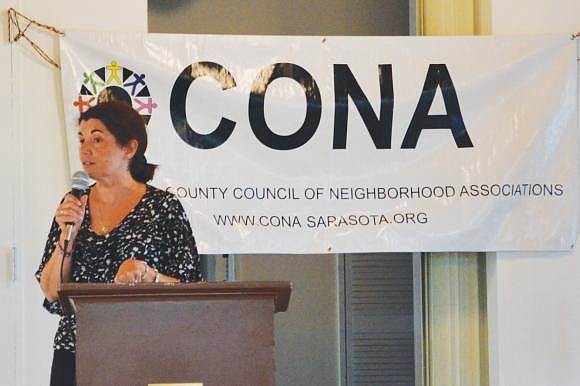- April 18, 2024
-
-
Loading

Loading

The Sarasota County Council of Neighborhood Associations (CONA) held a Monday-night panel discussion titled ‘Urban Services, Urban Realities,’ featuring downtown developer Jesse Biter, Downtown Improvement District board member Eileen Hampshire, Downtown Sarasota Alliance board member Vic Sully and New College Professor David Brain.
The panel, which fielded questions from the approximately 40 people in the audience, agreed on one key issue — the need for more affordable downtown housing to accommodate a young professional demographic.
“I’m here because I’m a big advocate for urban density,” said Biter, who created the HuB — a downtown co-working space that provides resources for entrepreneurs and start-ups. “One of the things I learned when I hired my employees is that they didn't have anywhere to live. It was frustrating for me to see someone spend 1.5 hours a day driving to work.”
CONA, which was created in 1961, comprises more than 70 area neighborhoods, homeowner associations, condominium associations and civic organizations, representing the interests of more than 70,000 area residents.
CONA President Lourdes Ramirez argued Monday that the Sarasota County Commission’s recent proposal to loosen the urban planning and fiscal neutrality requirements of the original 2050 plan will encourage development sprawl in east Sarasota County, forcing city taxpayers to foot the bill for the infrastructure — such as roads and sewers — needed to accommodate the new urban areas.
With County Commissioner Nora Patterson in the audience, Ramirez took a dig at the BCC, criticizing the work of a consultant recently hired by the commission to analyze the effects of proposed changes to 2050, claiming the consultant's report reflected what "developers wanted to hear."
The original 2050 plan, approved by the County Commission in 2002, was designed to prevent urban sprawl in Sarasota County east of I-75, protect the environment and set rules on community layout based on “New Urbanist” design principals such as walkable communities and increased housing density. The original 2050 plan also required fiscal-neutrality safeguards to prevent the costs of development from being passed on to taxpayers.
Advocates of changing 2050 claim the plan’s original form is not workable, and could lead to “rural sprawl” eating up space for future development with low-density ranch homes.
Due to sluggish growth during the recession and after listening to developers’ concerns, Sarasota County Commissioners recently proposed modifying 2050 to loosen some of the design parameters and density requirements and open the door to county-funded infrastructure projects that could incentivize developers.
Contact Nolan Peterson at [email protected]